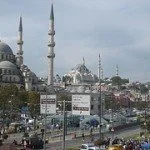Istanbul
14 October 2012
My sister, Sally has flown out from Holland to join me for the weekend in Istanbul.
Together we have explored the sights, wandered the streets and wined and dined. It has been great to catch up on news and share this magical city together. We wandered through the labyrinth of narrow alleys around the Grand bazaar and Spice market, where we spotted fabrics, spice, jewellery, copper items and carpets, from many of the countries that I have travelled through. These were being sold in a wide range of shops and small stores arranged like Aladdin's caves along these streets.
Outside the Grand bazaar, we ceremoniously exchanged a piece of silk that I have carried with me from Japan: a representation of the journey this fabric used to make to get to these stalls in the hub of Istanbul's trade centre.
The Aya Sofya, the Church of Divine Wisdom, stands in the centre of the Sultanahmet area and was one of the most impressive builds I have seen. Built in 527 - 65, by Emperor Justinian as part of his efforts to restore the greatness of the Roman Empire, the building reigned as the greatest church in Christendom until the Conquest in 1453. Mehmet the Conqueror had the church converted into a mosque and so it remained until 1935 when Ataturk proclaimed the building was to become a museum and restoration work began. The Christian figures represented in mosaics and frescos were uncovered and restored, and Islamic designs, window panes and the eight large medallions inscribed with gilt Arabic letters, were enhanced. Beautifully lit by huge low hanging light fittings, the building is a unique secular place to contemplate and marvel at the devotion and talents of by gone people and the changes that Istanbul has absorbed over the centuries.
Next door is the huge Ottoman Blue Mosque, built in 1603 - 17 under the orders of the reigning Sultan Ahmet, who wanted a monument that would rival the Aya Sofya. The stained glass windows and Iznik tiles lining the walls were amazing to see. Here you can appreciate the impact of a place devoid of pictures of people and animals and understand how a space decorated only with geometric patterns and simpler design work can be conducive to focused worship. It was interesting to see how small the women's area was in this huge mosque.
We wandered through the many rooms of the Topkapi palace which sits on the edge of the peninsular over looking the Bospherous. The palace has a colourful history of sad, mad or bad Ottomans who lived in the building between 1453 and 1839. Mehmet the conqueror lived in the palace from 1453 -1481. Other sultans lived there until the 19 th century. There are huge areas of incredible tiling within the rooms and pavilions and the most amazing displays of decorative weapons, clothes and objects. The craft work was marvellous to see.
Sal and I have sampled many of the Turkish delicacies: thick coffee, delicious sweets full of various nuts, mezes and of course, fish....in atmospheric pavement restaurants and cafes full of character. We have met great characters, had hilarious conversations, discovered some brilliant music and stroked loads of stray cats and dogs which roam the park areas (you'd love the animals here Em). We also indulged in a Turkish bath experience, a must in this country and made all the more memorable as we visited the famous Cogaloglu hamami which even Kate Moss raves about.


















